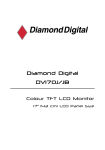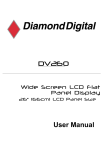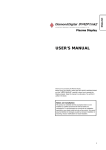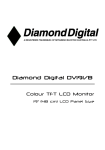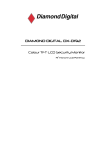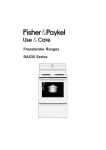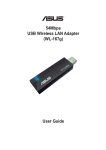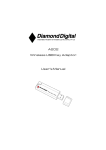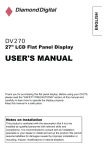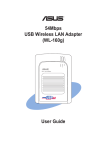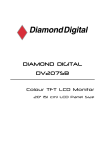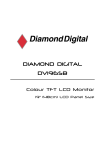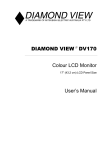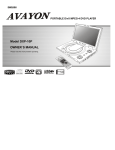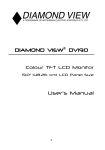Download Mitsubishi A101 User guide
Transcript
A101 Wireless USB A daptor Adaptor User’ s Manual User’s Copyright 2004, Mitsubishi Electric Australia Pty. Ltd. All rights reserved. No part of this publication may be reproduced, transmitted, transcribed, stored in a retrieval system or translated into any language or computer language, in any form or by any means, electronic, mechanical, magnetic, optical, chemical, manual or otherwise, without the prior written permission. Disclaimer Mitsubishi Electric Australia Pty. Ltd. makes no representations or warranties, either expressed or implied, with respect to the contents hereof and specifically disclaims any warranties, merchantability or fitness for any particular purpose. Further, Mitsubishi Electric Australia reserves the right to revise this publication and to make changes from time to time in the contents hereof without obligation to notify any person of such revision or changes. Diamond Digital is a registered trademark of Mitsubishi Electric Australia Pty. Ltd. Microsoft and Windows are registered trademarks of Microsoft Corporation. All other trademarks remain the property of their respective owners. Chapter 1: Product introduction 1.1 1.2 1.3 1.4 1.5 Welcome! ........................................................................... 1-2 Package contents ............................................................... 1-2 Features ............................................................................. 1-3 1.3.1 Top view ................................................................. 1-3 1.3.2 Bottom view ........................................................... 1-3 1.3.3 Rear view ............................................................... 1-4 LED indicators .................................................................... 1-4 Network setup .................................................................... 1-5 1.5.1 Ad-hoc network ...................................................... 1-5 1.5.2 Infrastructure network ............................................ 1-5 Chapter 2: Installation 2.1 2.2 2.3 System requirements ......................................................... 2-2 Installation procedures ....................................................... 2-2 2.2.1 Installing the device drivers and utilities................. 2-2 2.2.2 Installing the device ............................................... 2-3 Placement .......................................................................... 2-3 2.3.1 Wall mounting ........................................................ 2-4 Chapter 3: Software support 3.1 iv Control Centre .................................................................... 3-2 3.1.1 Control Centre icons .............................................. 3-2 3.1.2 Control Centre right-click menu ............................. 3-3 3.1.3 Control Centre left-click menu ................................ 3-3 Features Contents Contents Safeguards 3.2 3.3 3.4 Wireless Settings ................................................................ 3-4 3.2.1 Status ..................................................................... 3-4 3.2.2 Configuration ......................................................... 3-7 3.2.3 Site Survey ............................................................ 3-9 3.2.4 About Wireless Settings ....................................... 3-10 3.2.5 Link State ............................................................. 3-10 3.2.6 Command icons .................................................... 3-11 3.2.7 Other right-click options ........................................ 3-11 Mobile Manager ................................................................ 3-13 3.3.1 The Main Menu .................................................... 3-15 3.3.2 Creating a new configuration ............................... 3-15 3.3.3 Editing a configuration ......................................... 3-19 Site Monitor ...................................................................... 3-23 3.4.1 Launching Site Monitor ........................................ 3-23 3.4.2 Site Monitor main window .................................... 3-23 3.4.3 Monitoring a connection ....................................... 3-24 Chapter 4: Troubleshooting Troubleshooting ........................................................................... 4-2 Service Contacts ......................................................................... 4-5 v About this guide This user guide contains the information you need to install and configure your A101 Wireless USB Adaptor. How this guide is organised This guide contains the following parts: • Chapter 1: Product introduction This chapter describes the physical features of the A101 Wireless USB Adaptor. This section also presents the package contents, LED indicators, and recommended network settings. • Chapter 2: Hardware installation This chapter provides information on how to install the A101 Wireless USB Adaptor. • Chapter 3: Configuration This chapter provides information on the contents of the Driver CD. • Chapter 4: Troubleshooting This chapter contains a troubleshooting guide for solving common problems you may encounter when using the A101 Wireless USB Adaptor. Conventions used in this guide To make sure that you perform certain tasks properly, take note of the following symbols used throughout this guide. WARNING: Information to prevent injury to yourself when trying to complete a task. CAUTION: Information to prevent damage to the components when trying to complete a task. IMPORTANT: Information that you MUST follow to complete a task. NOTE: Tips and additional information to aid in completing a task. vi A101 specification summary* Standard IEEE 802.11g Interface USB 2.0 Technology Orthogonal Frequency Division Multiplexing (OFDM) Direct Sequence Spread Spectrum (DSSS) Data transfer rate 802.11g: 54Mbps with auto-fallback to 48, 36, 24, 18, 12, 9, and 6Mbps 802.11b: 11Mbps with auto-fallback to 5.5, 2, and 1Mbps Network types Supports Infrastructure and Ad-hoc networks Frequency band 2.4 GHz ~ 2.5 GHz Security 64-bit/128-bit configurable WEP & WPA encryption Operating distance Indoors @ 11Mbps Indoors @ 54Mbps Outdoors @ 11Mbps LOS** Outdoors @ 54Mbps LOS** Compatibility Compatible with IEEE 802.11b and 802.11g devices Power requirement Powered USB port Dimensions 86mm x 62mm x 17mm Supported OS Windows® 2000 (SP4)/XP (SP1) Antenna Two internal 3D Inverted-F antennas Mounting options Desktop or wall installation Software support Control Center Wireless Settings Mobile Manager Site Monitor TroubleShooting : : : : 130 ft (40 m) 80 ft (25 m) 1000 ft (310 m) 200 ft (60 m) * Specifications are subject to change without notice. ** Line-of-Sight The A101 operating distance may be shorter if there are walls, barriers, or interferences in the home layout or operating environment. vii Chapter 1 This chapter describes the physical features of the A101 Wireless USB Adaptor. This part presents the package contents, LED indicators, and recommended network settings. Product Introduction 1.1 Welcome! Thank you for choosing the A101 Wireless USB Adaptor! The A101 is an easy-to-install wireless LAN adaptor. Conforming to the IEEE 802.11g standard for wireless local area networks (WLAN), the A101 is capable of up to 54Mbps data transmission rate using the Direct Sequence Spread Spectrum (DSSS) and the Orthogonal Frequency Division Multiplexing technologies. The A101 also comes with the latest wireless technology to keep you ahead in the world of wireless computing. 1.2 Package contents Check the following items are in your A101 Wireless USB Adaptor package. Contact your retailer if any item is damaged or missing. Diamond Digital USB Wireless LAN Adaptor (A101) USB cable Driver CD Quick Start Guide Unless otherwise specified, the term “device” in this User Guide refers to the A101 Wireless USB Adaptor. 1-2 Chapter 1: Product introduction 1.3 Features 1.3.1 Top view LEDs: The A101 Wireless USB Adaptor comes with three LED indicators. Refer to section 1.4 “LED indicators” for details. LEDs 1.3.2 Bottom view Mounting hole: Use the mounting hole to install the device on concrete or wooden surfaces using a roundhead screw. Air vents: These vents provide ideal ventilation to the device. Mounting hole Air vents Diamond Digital A101 Wireless USB Adaptor 1-3 1.3.3 Rear view USB port. This USB port connects the device to a computer via the supplied USB cable. USB port 1.4 LED Indicators The device comes with Power, Activity, and Link LED indicators. Refer to the table below for LED indications. LED Status Power On Off Indication The adaptor is receiving power from the USB port. The adaptor is not receiving power from the USB port. The USB cable may be disconnected or the computer is off. Activity Blinking The adaptor is transmitting or receiving data packets. Link 1-4 On The adaptor is linked to a wireless network. Blinking The adaptor is searching for a wireless network to connect to. Chapter 1: Product introduction 1.5 Network setup The A101 Wireless USB Adaptor may be used in both Ad-hoc and Infrastructure network types. The following sections decribe the device functions in these network types. Determine your network settings before installing the device to make all its features available. The following network settings are recommended. 1.5.1 Ad-hoc network In an Ad-hoc network type, the device connects to another wireless LAN adaptor in a wireless network. No access point (AP) is present in this wireless environment. 1.5.2 Infrastructure network In an Infrastructure network, the wireless network is centered on an access point (AP) that provides a central link for wireless clients to communicate with each other or with a wired network. INTERNET ADSL Modem Access Point Diamond Digital A101 Wireless USB Adaptor 1-5 Chapter 2 This chapter provides information on how to install the A101 Wireless USB Adaptor. Installation 2.1 System requirements Before installing the A101 Wireless USB Adaptor, make sure that your system meets the following requirements: • • • • • Intel® Pentium® 4 or AMD K7/K8 system Minimum 64MB system memory Windows® 2000 (SP4)/XP (SP1) operating system Optical drive (for software installation) An available USB port (USB 2.0 recommended) 2.2 Installation procedures Follow these instructions to install the A101 Wireless USB Adaptor in your computer. 1. Install the device drivers and utilities from the Driver CD. 2. Connect the device to your computer. You must install the A101 drivers and utilities before connecting the device to your computer. 2.2.1 Installing the device drivers and utilities To install the device driver and utilities on your computer: 1. Insert the Driver CD into the optical drive. 2. Click “Install A101 Wireless USB Adaptor Utilities/Driver” when the installation window appears. 3. Follow the prompts to install the A101 drivers and utilities, then restart the computer once installation is complete. If Autorun is NOT enabled on your computer, browse the contents of the Driver CD and double click the Setup.exe file to run the CD. 2-2 Chapter 2: Installation 2.2.2 Installing the device To install the A101 Wireless USB Adaptor in your computer: 1. Connect one end of the USB cable to the USB port of the device. 2. Connect the other end of the USB cable to the USB port of your computer. 3. Windows® automatically detects the device and displays the Found New Hardware dialogue box. Follow the on-screen instructions to proceed. 1 2 4. After completing installation, configure the A101 Wireless USB Adaptor using the Wireless Settings utility. Refer to the next chapter for details. 2.3 Placement Take note of the following before placing the device. • Place the device on a flat, stable surface as far from the ground as possible • Keep the device away from metal obstructions and direct sunlight. • Keep the device away from transformers, heavy-duty motors, fluorescent lights, microwave ovens, refrigerators and other industrial equipment to prevent interference and signal loss. Diamond Digital A101 Wireless USB Adaptor 2-3 2.3.1 Wall mounting Aside from desktop placement, you may install the A101 Wireless USB Adaptor vertically on a concrete or wooden wall using the mounting hook at the bottom of the device and a mounting screw. Mounting hook To mount the device on a concrete or wooden wall: 1. Locate the mounting hook on the bottom of the device. 2. Select an ideal location for the device following the considerations mentioned previously. 3. Tighten a round head screw on the concrete or wooden wall until only 1/4” is showing. 4. Latch the device onto the screw. Adjust the screw if you cannot latch the device or if the screw is too loose. 2-4 Chapter 2: Installation Chapter 3 This chapter provides information on the software and utilities supplied on the Driver CD Softw are Suppor t Software Support 3.1 Control Center The Control Center utility is management software that launches applications and configures network settings. Clicking the A101 Control Center on the desktop starts the program and displays a Control Center icon in the Windows® taskbar. The Control Center icon serves as an application launcher and indicator of signal quality and Internet connection. 3.1.1 Control Center icons The Control Center icon indicates the quality of link to the access point and connection to the Internet. Refer to the table below for icon indications. Infrastructure network (Wireless USB adaptor to an access point) Excellent link quality and connected to the Internet Excellent link quality but not connected to the Internet Good link quality and connected to the Internet Good link quality but not connected to the Internet Fair link quality and connected to the Internet Fair link quality but not connected to the Internet Poor link quality but connected to the Internet Poor link quality and not connected to the Internet Not linked but connected to the Internet Not linked and not connected to the Internet Ad-hoc network (Wireless USB adaptor to other Wi-Fi device) Linked Not Linked Connected to the Internet 3-2 Chapter 3: Software Support 3.1.2 Control Center right-click menu Right-clicking the Control Center icon displays the software and utilities for the A101 Wireless USB Adaptor. Refer to the following sections for details on these utilities and software programs. 3.1.3 Control Center left-click menu Left-clicking the Control Center icon displays the left-click menu. Search & Connect – View available wireless networks within range. Wireless Option – Sets your Windows® XP wireless networking environment. The Wireless Option window appears when you select this option. Select “Only use Diamond Digital WLAN utilities and disable Windows wireless function” to activate all A101 USB Wireless LAN Adaptor features. Click OK. Diamond Digital A101 Wireless USB Adaptor 3-3 3.2 Wireless Settings The Wireless Settings is the main interface that allows you to control the A101 Wireless USB Adaptor. Use the Wireless Settings to view the operational and connection status, or to modify the Wireless USB adaptor configuration. The Wireless Settings window is composed of the property window and tabbed property sheets. Click the icons in the property window to display their tabbed property sheets. 3.2.1 Status Status tab The Status tab provides general information on the wireless USB adaptor. Association State. This field displays the connection status and MAC address of the network device the unit is connected to. Service Set Identifier (SSID). This field displays the SSID of the network to which the adaptor is associated or is intending to join. The SSID is a group name shared by every member of a wireless network. Only client PCs with the same SSID are allowed to establish a connection. The MAC Address field displays the hardware address of the adaptor connected to a network. The Current Channel field displays the radio channel that the adaptor is currently tuned to. The channel changes as the Wireless USB adaptor scans the available channels. The Current Data Rate field displays the data transfer rate between the Wireless LAN adaptor and the access point. 3-4 Chapter 3: Software Support Rescan button - Click to allow the Wireless USB adaptor to scan available wireless networks and to connect to the network with the best signal quality. Change SSID button - Click to change the SSID. Clicking this button opens the Config-Basic window. See “Basic tab” on page 3-7. Search and Connect button - Click to view all wireless networks within the range of your system. Clicking this button opens the Site Survey window. See page 3-9. Connection tab The Connection tab provides real-time information on connection throughput, frame errors, signal strength, link quality and overall connection quality in graphical form. IP Config tab The IP Config tab displays the current host and Ethernet adaptor configurations. IP Config displays TCP/IP information including the IP address, subnet mask, default gateway, DNS and Windows Internet Naming Service (WINS) configurations. Use the IP Config Tab to verify your network settings. IP Release. Click to release the DHCP IP address for the Wireless USB adaptor. IP Renew. Click to renew the DHCP IP address for the Wireless USB adaptor. Ping. Click to display the Ping tab. Use ping to verify a connection to a particular host name or IP address. The IP Release and IP Renew buttons may only be used on a DHCP-configured Wireless USB adaptor. Diamond Digital A101 Wireless USB Adaptor 3-5 Ping tab The Ping tab allows you to verify the connection of your computer with another computer in the network. To ping a connection: 1. Type the IP address of the connection you want to verify in the IP Address field. 2. Configure the ping session by assigning the size and count of packet to send, and the time limit for a ping session to continue (in milliseconds). 3. Click the Ping button. During the ping session, the Ping button toggles into a Stop button. Click Stop anytime to cancel the ping session. The Session field displays information on the verified connection including the roundtrip time (minimum, maximum, and average) and packets sent, received, and lost after a ping session. Click the Clear button to clear the session field. 3-6 Chapter 3: Software Support 3.2.2 Configuration Basic tab The Basic tab provides general information on network types and other configurations. Network Type. Select the type of network that you wish to use. Select Infrastructure mode to establish a connection with an access point (AP). In this mode, your system can access wireless LAN and wired LAN (Ethernet) via the AP. Select the Ad-Hoc mode to communicate directly with other mobile clients within the Wireless LAN adaptor range. Network Name - Displays the network SSID. The network SSID is a string used to identify a wireless LAN. Assign different SSIDs to segment the wireless LAN and increase network security. Set the SSID to a null string to allow your station to connect to any available access point. A Null string may not be used in Ad-hoc mode. Channel. In Infrastructure mode, the wireless USB adaptor automatically tunes in to the access point channel. In Ad-hoc mode, select a channel that is allowed for use in your country/region. Data Rate. Sets the data transmission rate to Fix or Auto. Select Fully Auto to allow the device to adjust to the most suitable connection. You may also fix data transfer rates to 54, 48, 36, 24, 18, 12, 11, 9, 6, 5.5, 2 and 1 Mbps. Operating the device at very high data rates reduces the operating range. PS Mode. This field allows control of the Wireless USB adaptor power saving features. The CAM (Constantly Awake mode) is recommended for systems running on AC power. Other options include MAX_PSP (Maximum power savings) and Fast_PSP (Fast power-saving mode) Others. Click the WEP or Advanced link to open the Encryption or Advanced property tab sheet. Diamond Digital A101 Wireless USB Adaptor 3-7 Encryption tab Wireless data transmissions between your Wireless LAN adaptor and the AP are secured using the Wired Equivalent Privacy (WEP) encryption. Check the Data encryption (WEP enabled) option to assign the WEP keys. Check the Network Authentication (Shared Mode) option if you wish to use a network key to authenticate a preferred wireless network. Unchecking this option allows the network to operate on an Open System mode. Key Format allows you to set a hexadecimal digit or ASCII character WEP key. Key Length allows you to choose a 64-bit or a 128-bit WEP key. A 64-bit encryption contains 10 hexadecimal digits or 5 ASCII characters. A 128-bit encryption contains 26 hexadecimal digits or 13 ASCII characters. All wireless clients in a network must have identical WEP keys to communicate with each other or with an access point. Two ways to assign WEP keys Manual Assignment. For a 64-bit encryption, enter 10 hexadecimal digits (0~9, a~f, A~F) or 5 ASCII characters in each of the four WEP keys. For 128-bit encryption enter 26 hexadecimal digits (0~9, a~f, A~F) or 13 ASCII characters in each of the four WEP keys. Automatic Generation. Type a combination of up to 64 letters, numbers, or symbols in the Passphrase field. The Wireless Settings utility uses an algorithm to generate four WEP keys based on the typed combination. 3-8 Chapter 3: Software Support • 64-bit and 40-bit WEP keys use the same encryption method and can interoperate on wireless networks. This lower level of WEP encryption uses a 40-bit (10 hexadecimal digits assigned by the user) secret key and a 24-bit Initialisation Vector assigned by the wireless LAN adaptor. 104-bit and 128-bit WEP keys also use the same encryption method. • After assigning the WEP keys, click APPLY to save and activate the encryption. Manually assigned encryptions are more secure than automatically generated encryptions. • Use Manual Assignment instead of Automatic Generation if you are not sure whether other wireless clients use the same algorithm as that of the Wireless LAN adaptor. • Keep a record of the WEP encryption keys. 3.2.3 Site Survey The Site Survey window displays the available networks within the wireless LAN adaptor range and the following network settings. BSSID - The IEEE MAC address of the available wireless networks. SSID - SSID (Service Set Identifier) of the network. CH - Direct sequence channel used by the network. RSSI - Received Signal Strength Indicator (RSSI) in dB.. Encryption - shows whether a network has enabled WEP encryption enabled or disabled. Select an available network and click Connect to establish a connection. Click Search to rescan available networks. Diamond Digital A101 Wireless USB Adaptor 3-9 3.2.4 About Wireless Settings Click the About icon to view the software version, driver version, and copyright information. 3.2.5 Link State Displays the current connection status of the Wireless USB adaptor to the AP or to other Wi-Fi devices. An icons represents the Link State for easy identification. Refer to the table below for icon indications. Table of Icon Indications Excellent link quality (Infrastructure) Good link quality (Infrastructure) Fair link quality (Infrastructure) Poor link quality (Infrastructure) Not linked (Infrastructure) Linked (Ad-hoc) Not linked (Ad-hoc) 3-10 Chapter 3: Software Support 3.2.6 Command icons Apply. Click to apply the changes made on the Wireless Settings utility. OK. Click to close the Wireless Settings utility window. Cancel. Click to cancel any changes made on the Wireless Settings utility. Clicking Cancel closes the Wireless Settings utility window. Help. Click to display the help menu. 3.2.7 Other right-click options Activate Configuration This option allows you to select the wireless profile to use. Mobile Manager Click this button to launch the Mobile Manager utility. See section 3.2 “Mobile Manager” for details. Site Monitor Click this button to launch the Site Monitor utility. See section 3.3 “Site Monitor” for details. Help Menu The Control Center utility has a Help menu to guide you in using the Control Center and Wireless Settings utilities. Right-click the Control Center icon, then select Help. Select a utility to display the help window. Preferences The Preferences window allows you to customize the Control Center utility settings. Diamond Digital A101 Wireless USB Adaptor 3-11 About Control Center Select the About Control Center option to display the Control Center software version and copyright information. 3-12 Chapter 3: Software Support 3.3 Mobile Manager The Mobile Manager is a convenient tool to set up and manage network location settings. This utility allows users to configure multiple alternative configurations for different locations. You need to set up this utility so you can easily switch configurations when you change your location. To launch the Mobile Manager utility: 1. Click the Windows® Start button. Select Programs > A101 Wireless LAN Adaptor > Mobile Manager, or right-click the Control Center icon on the Windows® taskbar, then select Mobile Manager. 2. The Mobile Manager main window appears. 3.3.1 The Main Window You may use the Mobile Manager utility main window to create, edit, or activate a configuration. The main window displays the menu bar, tool bar, and existing configurations. The toolbar buttons allow quick access to some common commands in the Mobile Manager utility. All toolbar button commands are also available from the menu bar. Diamond Digital A101 Wireless USB Adaptor 3-13 File menu New Configuration – Select this option to launch the New Configuration Wizard. See the next section for details. Import Configuration an INI File. – Select this option to load a configuration from Export Configuration – Save the selected configuration (containing Wireless Settings, TCP/IP Settings, Network Settings, etc.) to an INI file. The INI file may be saved on a floppy disk, and may be imported by other computers with the Mobile Manager utility. You may also use this file as backup. Exit – Select to close the Mobile Manager utility. Mobilise menu Auto Roaming – Activating this option allows the A101 Wireless USB Adaptor to switch to another association you have specified when changes to an existing association occur. If no associations are made, Auto Roaming automatically connects to a wireless network based on your specified configurations. Activate Configuration – Applies the configuration you selected from the list. Follow the screens instructions to activate a configuration. Windows® 2000/XP OS does not require system restart after you activate a configuration. Edit menu Edit Configuration – The Edit Configuration option allows you to edit selected configuration items. See the “Editing a Configuration” section on page 3-19 for details. Rename – Changes the name of the selected configuration. Copy – Duplicates the selected configuration. Delete – Discards the selected configuration. Up – Raises the position of a selected wireless network configuration in the preferred network list. 3-14 Chapter 3: Software Support Down – Lowers the position of the selected wireless network configuration in the preferred network list. Edit menu commands appear when you right-click a configuration in the Mobile Manager window. View menu Large Icons – Displays large icons for each configuration. Small Icons – Displays small icons for each configuration. List – Shows a list of available configurations. Details – Displays the name, type, and description of a selected configuration. Help menu Contents – Displays the WinHelp window for online help. About Mobile Manager – Displays the Mobile Manager version number and copyright information. 3.3.2 Creating a new configuration To create a new configuration: 1. Launch the New Configuration Wizard by clicking File from the menu bar, then select New Configuration from the drop-down menu, or single-click the New Configuration icon on the Mobile Manager toolbar. The New Configuration Wizard dialog box appears. Diamond Digital A101 Wireless USB Adaptor 3-15 2. Choose the type of configuration you want to create. The configuration types are described below. Click Next when done. • Diamond Digital Wireless Local Area Networking . Select this option if you have an installed A101 Wireless USB Adaptor in your computer. • Wired Local Area Network Configuration. Select this if your computer has an installed network interface card other than A101 Wireless USB Adaptor. • Dialup Networking Configuration. Select this option if your computer has an installed modem. 3. Enter the name and description of the configuration you wish to create, then click Next. 3-16 Chapter 3: Software Support 4. Configure the wireless settings including the network type, SSID, channel and WEP encryption. Click Next when done. 5. Set the IP address of the configuration using this window. Specify the IP address using the DHCP server (automatic) or manual assignment. The wizard auto-detects and displays the current system settings. Click Next when done. 6. Enter the computer name, then click Next. Diamond Digital A101 Wireless USB Adaptor 3-17 7. Use this window to set the proxy server and printer sharing. Click Advanced to display the proxy server and printer sharing options. Click Next when finished. 8. Check the Activate Configuration Now option to start using the created configuration. The Mobile Manager window displays the created configuration when it is not activated. Click Finish to close the wizard. 3-18 Chapter 3: Software Support 3.3.3 Editing a configuration To edit a configuration: 1. Select a configuration from the Mobile Manager window. 2. Click Edit from the menu bar, then select Edit Configuration. The Edit Configuration dialog box appears. Navigate through the windows by clicking the buttons on the left. General settings Name – The configuration name indicates the location from where you are dialing or connecting to a network. For example, name your configuration “Work-Meeting Room” if you are using this connection at your workplace meeting room. Description – Enter additional details of the configuration in this field. This field is optional. Network settings - Wireless tab Priority of Preferred Network – This field allows you to select the priority of the preferred network. Network Type Infrastructure – Select the Infrastructure mode to establish connection to an access point. Ad hoc – Select the Ad hoc mode to communicate directly with other WLAN devices without using an access point. Diamond Digital A101 Wireless USB Adaptor 3-19 SSID – SSID stands for Service Set Identifier, a string used to identify a wireless LAN. You can only connect with an Access Point, that has the same SSID. Use different SSIDs to segment the wireless LAN and add security. Channel – The Channel field allow you to select the radio channel for the A101 Wireless USB Adaptor. In an Infrastructure network, your wireless LAN adapter automatically selects the correct frequency channel required to communicate with an Access Point. WEP – This option allows you to disable or enable (64-bit or 128-bit) WEP encryption. The WEP Key is a 64-bit (5 character) or 128-bit (13 character) hexadecimal code used to encrypt transmitted data packets and decrypt received data packets. Network settings - Identification tab Computer name – Assign your computer a unique name of up to 15 characters. The computer name allows other users in a network to recognize your computer. The computer name is generally the same with the DNS hostname. Avoid using spaces or symbols in your computer name. TCP/IP settings - Device tab Select the network adaptor you want to use for this configuration. This item appears only when you are editing a wired LAN configuration. TCP/IP settings-IP Address tab Obtain an IP address from a DHCP server – The Dynamic Host Configuration Protocol (DHCP) server assigns IP addresses automatically within a specified range of devices. 3-20 Chapter 3: Software Support Specify an IP address – Ask your network administrator for the IP address and subnet mask you should use. Type in the IP Address and Subnet Mask manually. TCP/IP settings - Gateway tab Specify the gateways. You may specify more than one gateway. Set up the primary gateway first. Add – Click this button to add a new TCP/IP gateway address. The added gateway appears in the Default gateways list. Repeat the process to add another gateway. The value in each gateway field must be between 0 and 255. You can have up to eight IP addresses for gateways. Edit – Click this button to edit a selected gateway address. Remove – Click this button to delete a selected gateway address. TCP/IP settings - DNS tab The DNS tab allows you to configure the DNS settings of the selected configuration. This tab also allows you to add a DNS server and arrange them in order of their use. You may also assign a DNS suffix for a specified DNS server. TCP/IP settings - WINS tab The WINS tab allows you to configure the WINS settings of the selected configuration. This tab allows you to add WINS addresses and arrange them in order of use. This tab also allows you to enable or import LMHOST lookup and adjust the NetBIOS settings. Internet settings A proxy server acts as a security barrier between your internal network (Intranet) and the Internet. A proxy server restricts other people on the Internet from gaining access to confidential information on your internal network or your computer. Disable Proxy Server – Allows you to disable the proxy server. Diamond Digital A101 Wireless USB Adaptor 3-21 Enable Proxy Server – Use the Proxy server to access the Internet. Use the same proxy server for all protocols – Specifies whether you want to use the same proxy server to gain access to the Internet using all protocols. Servers field – Provides fields for you to type the address and port number of the proxy server you want to use to gain access to the Internet over HTTP, Secure, FTP, Gopher or Socks protocol. Exceptions field Do not use proxy server for address beginning with – Type the Web addresses that do not need to be accessed through the proxy server. If you want to connect to a computer on your Intranet, make sure you type its address in this box. You may use wild cards to match domain and host names or addresses, for example, “*.company.com”, “192.72.111.*”. Bypass proxy server for local addresses – This option allows you to use the proxy server for all local (Intranet) addresses. You may gain access to local addresses easier and faster if you do not use the proxy server. Sharing settings I want to set the default printer– Allows you to select the default printer for printer sharing. Default printer – Allows you to select the default printer from a list of installed printers. Click New to add a new printer using the Windows® Add Printer Wizard. Click Properties to display the properties of a selected printer. Command buttons Use these buttons to activate, save, or cancel changes made in the configuration. Click Close to close the Edit Configuration window. Click Help to view the help files. 3-22 Chapter 3: Software Support 3.4 Site Monitor The Site Monitor utility measures the signal-to-noise (SNR) values of all available wireless networks. Use this utility to determine the best placement of access points in a wireless network. 3.4.1 Launching Site Monitor To launch the Site Monitor: • Click the Windows® Start button, then select Programs > A101 Wireless LAN Adaptor > Site Monitor, or • Right-click the Control Center icon on the Windows taskbar, then select Site Monitor. The Site Monitor survey message appears. Click OK. 3.4.2 Site Monitor main window The Site Monitor main window displays the available wireless connections and the signal-to-noise (SNR) value of a selected connection. Some Access Points disable their SSID broadcasting to hide themselves from “Site Survey” or “Site Monitor”. You may join these APs if you know their SSID. Diamond Digital A101 Wireless USB Adaptor 3-23 3.4.3 Monitoring a connection To monitor a connection: 1. Select the connection from the list. 2. Select Command from the menu bar, then select Monitor. You may also press <Ctrl> <M> on your keyboard. The Monitor window appears. The following connection parameters are displayed in a graphical representation. SNR. This indicates the quality of communications within the current network. The communication quality is based on signal level and noise level measurements. The higher the SNR, the better the connection quality. Communication Quality. This indicates the communication quality of the Basic Service Set to which the station is connected. Signal Level. This line specifies the average signal level of the Basic Service Set to which the station is connected. Noise Level. Specifies the average noise level of the Frequency Channel currently used for connection. Throughput. The Throughput graph sends a specified number of data packets to the remote host and calculates the average transmission rate in megabits per second. During the test, the Start button toggles to Stop. Click Start button to begin the link test. Click the Stop button at any time to stop the test. 3-24 Chapter 3: Software Support Chapter 4 This chapter contains a troubleshooting guide for solving common problems you may encounter when using the A101 Wireless USB Adaptor. Troubleshooting Troubleshooting This troubleshooting guide provides answers to some common problems which you may encounter while installing and/or using Diamond Digital Wireless LAN products. These problems require simple troubleshooting that you can perform by yourself. Contact the Wireless LAN Technical Support if you encounter problems not mentioned in this section. Problem My computer does not recognise the installed A101 Wireless USB Adapter. A yellow exclamation mark or a red cross sign appears on the A101 Wireless LAN Adaptor item. Action Verify if the A101 drivers are properly installed by following these instructions: 1. Open the Control Panel window from the Start menu. 2. Double-click on the System icon. 3. Windows® 2000/XP users: Select the Hardware tab then click the Device Manager button. 4. Click the “+” symbol preceding the Network Adapters item, then check the A101 Wireless LAN Adaptor item. A yellow exclamation mark or a red cross sign preceding the network adapter means that the device driver is not properly installed. Re-install the device driver following the instructions below. The device driver is not properly installed. Follow these instructions to uninstall and re-install the driver. 1. Insert the Support CD into the CD-ROM drive. 2. When the A101 Wireless USB Adaptor installation window appears, click “Uninstall A101 Wireless USB Adaptor Utilities/Driver” option. Diamond Digital A101 Wireless USB Adaptor 4-2 Troubleshooting Problem I cannot connect to an Access Point. I can connect to an Access Point but I cannot connect to the Internet. I cannot connect to another station with a wireless LAN device. Action 3. Restart your computer and repeat the software installation following the instructions contained in this User Guide. • Check if the Network Type of the device is set to Infrastructure mode. • Check if the device has the same Service Set Identifier (SSID) as that of the AP. • Check if the device and the AP have the same Encryption. If WEP encryption is enabled, set the same WEP keys for the device and the AP. • Check if the MAC address of the device is added in the AP Authorisation Table. Confirm this with your LAN administrator. • There is poor signal reception. Shorten the distance between the device and the access point. • Check if the device and the AP have the same Encryption. If WEP encryption is enabled, set the same WEP keys for the device and the AP. • Make sure the network protocol parameters (IP address, subnet mask, gateway, and DNS) of your computer are correctly set. • Check the proxy settings of the web browser. • Check if the Network Type of the device is set to Ad-hoc mode. • Check if the device has the same Service Set Identifier (SSID) with that of the other station. • There is poor signal reception. Shorten the distance between the device and the station. Diamond Digital A101 Wireless USB Adaptor 4-3 Troubleshooting Problem Action • Check if the device and the other station have the same Encryption. If WEP encryption is enabled, set the same WEP keys for the device and the AP. I cannot connect to other computers linked via an Access Point or Ad-hoc network. • Check if the device and the other APs and/ or clients have the same Encryption. If you enable WEP encryption, you must set the same WEP keys for the device and the other APs and/or clients. • Check the TCP/IP settings (IP address, subnet mask, gateway, and DNS) of your computer. • Enable file and printer sharing in each client computer to allow file sharing. I always have poor link quality and low signal. Do the following to achieve better link quality and stronger signal: • Keep the device away from microwave ovens and large metal objects to avoid radio interference. • Shorten the distance between the device and the AP/station. Why do I get the warning “Hi-Speed USB Device Plugged Into Non-Hi-Speed USB Hub” message when I connected the A101 USB Wireless LAN Adapter to the USB port? This warning mesage appears when you plug the A101 Wireless USB Adaptor into a USB 1.1 port. • For Windows® XP users, you need to upgrade your OS to Service Pack 1 to add USB 2.0 support. • For Windows® 2000 users, you must install Service Pack 4 in order to add USB 2.0 support. You can download these service packs from the Windows Update website (windowsupdate.microsoft.com) Diamond Digital A101 Wireless USB Adaptor 4-4 Service Contacts If problems remain after checking this manual, please contact your place of purchase or contact: Australian Service Contacts Visit the Customer Support section of Mitsubishi Electric Australia’s web site at: www.mitsubishielectric.com.au for details of your nearest Mitsubishi Electric Authorised Service Center or contact the Service Department for your state: New South Wales and Australian Capital Territory 348 Victoria Road Rydalmere, NSW, 2116 Telephone: (02) 1300 651-808 Fax: (02) 9684-7684 Queensland Unit 12, 469 Nudgee Road Hendra, QLD, 4011 Telephone: (07) 3623-2000 Fax: (07) 3630-1888 South Australia and Northern Territory 77 Port Road Hindmarsh, SA, 5007 Telephone: (08) 8340-0444 Fax: (08) 8340-0555 Victoria and Tasmania 4 / 303 Burwood Hwy East Burwood, VIC, 3151 Telephone: (03) 9262-9899 Fax: (03) 9262-9850 Diamond Digital A101 Wireless USB Adaptor 4-5 Western Australia 5 / 329 Collier Road Bassendean, WA, 6054 Telephone: (08) 9377-3411 Fax: (08) 9377-3499 New Zealand Contact: BDT New Zealand Ltd. 1 Parliament St. Lower Hutt Wellington Telephone: (04) 560-9100 Fax: (04) 560-9140 Web site: www.bdt.co.nz Diamond Digital A101 Wireless USB Adaptor 4-6
















































